The Visible Voices
The Visible Voices podcast amplifies voices that are Visible and those that may be Invisible. We speak on topics related to healthcare, equity, and current trends. Based in Philadelphia, and hosted by physician Resa E. Lewiss, we really like speaking with people like you.
Episodes
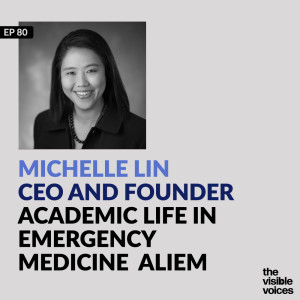
Friday Sep 23, 2022
Friday Sep 23, 2022
Michelle Lin MD is the Founder and CEO of AliEM. She is a Professor and Digital Innovation Lab Director in the Department of Emergency Medicine at the University of California, San FranciscoALiEM started out as an educational blog in 2009 for Dr. Michelle Lin to store Tricks of the Trade notes, has now evolved into an umbrella organization, housing online educational platforms and virtual communities. Our dynamic, globally distributed team continues to grow now with over 100 volunteer members, comprised of physicians, residents, students, pharmacists, nurses, and paramedics. We value dedication and creativity over experience and welcome all like-minded torchbearers in healthcare.Books Michelle suggests: Flash Foresight by Daniel Burrus and John David Mann [Amazon]Radical Candor by Kim Scott [Amazon]Rest by Alex Soojung-Kim Pang [Amazon]Speed of Trust by Stephen M.R. Covey [Amazon]Steal Like an Artist by Austin Kleon [Amazon]The One Thing by Gary Keller and Jay Papasan [Amazon]
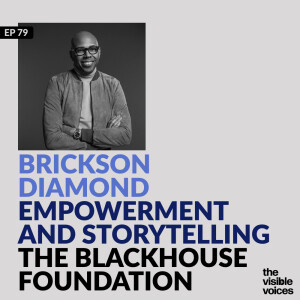
Saturday Sep 17, 2022
Saturday Sep 17, 2022
Brickson Diamond is a partner in the Technology, Media, Telecommunications and Services practice of the leadership advisory firm, Spencer Stuart. He has a specific focus on supporting media clients and advising across the firm’s Americas region on client-facing diversity equity and inclusion efforts. Brickson also serves on the board of Gentreo, an early-stage private company that provides technology-enabled solutions for estate planning sold to businesses as a benefit to employees, members and affiliated individuals. Prior to joining Spencer Stuart in late 2021, Brickson was CEO of Big Answers, LLC, an independent human capital advisory firm focused on helping leaders evolve enterprises by setting diversity strategy, sourcing senior-level diverse talent and instituting governance excellence in the fields of entertainment, technology, investment management and philanthropy. He previously served for five years as COO of The Executive Leadership Council, the preeminent member organization of Black executives in the Fortune 1000. Brickson began his career and spent 15 years as a marketing and client services executive with The Capital Group Companies, a $2.6 trillion global asset management firm.Brickson is a founding board member and chair of The Blackhouse Foundation, which provides pathways for Black multi-platform content creators into career opportunities within film, television, digital and emerging platforms. Brickson is a trustee of The Cooper Union for the Advancement of Science and Art, the Middlesex School and Tides. He serves on the investment committee of the Annenberg Foundation Trust at Sunnylands, is an advisor to VC Include, a platform that was created to accelerate investment into diverse emerging managers, and Smashcut, an online education platform for the visual arts. Brickson is a graduate of Brown University and the Harvard Business School.
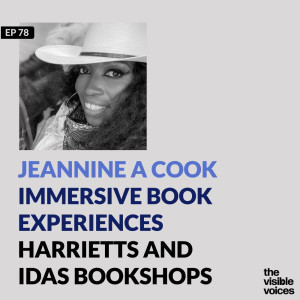
Thursday Jul 28, 2022
Thursday Jul 28, 2022
Jeannine A. Cook the founder and business owner Harrietts and Idas Bookshops. For the last 10 years she worked as a trusted creative writer for several startups, corporations, non-profits, and influencers. Jeannine is a Leeway Art & Transformation grantee and a winner of the South Philly Review Difference Maker Award. She recently returned from Nairobi, Kenya; Johannesburg, South Africa; and Birmingham, UK facilitating trainings on racism, colonialism, and imperialism with youth from 15 countries around the world. Jeannine is known for her "out of the box" approaches to organizing through guerrilla style creative writing.Oprah Daily Travel and LeisureWNBC News

Thursday Jul 21, 2022
Thursday Jul 21, 2022
Suzanne Koven, received her B.A. in English literature from Yale and her M.D. from Johns Hopkins. She also holds an M.F.A. in nonfiction from the Bennington Writing Seminars. After her residency training at Johns Hopkins Hospital, she joined the faculty of Harvard Medical School and has practiced primary care internal medicine at Massachusetts General Hospital for over 30 years. She is an associate professor of medicine at HMS and holds the Valerie Winchester Family Endowed Chair in Primary Care Medicine at Mass General. In 2019 she was named inaugural Writer in Residence at Mass General. Her essays, articles, blogs, and reviews have appeared in The Boston Globe, The New England Journal of Medicine, The Lancet, NewYorker.com, Psychology Today, The L.A. Review of Books, The Virginia Quarterly, STAT, and other publications. Her monthly column “In Practice” appeared in The Boston Globe and won the Will Solimene Award for Excellence in Medical Writing from the American Medical Writers Association in 2012. Dr. Koven co-directs the Media and Medicine certificate course at HMS and speaks to a wide variety of audiences on literature and medicine and the role of women in medicine. Her essay collection, Letter to a Young Female Physician, was published by W.W. Norton & Co. in 2021.

Thursday Jul 14, 2022
Thursday Jul 14, 2022
Soldedad O'Brien is award-winning journalist; anchor and producer for Matter of Fact with Soledad O’Brien; founder and CEO of Soledad O’Brien Productions Soledad O’Brien Productions is a multi-platform media production and distribution company dedicated to uncovering stories on the divisive issues of race, class, wealth, poverty, and opportunity through personal narratives. Soledad O’Brien has spent her career championing the stories of marginalized communities, and has been the recipient of three Emmy awards, the George Foster Peabody Award, and the Alfred I. DuPont Award for her reporting work. SO’B Productions has produced a number of documentaries, including the Black in America and Latino in America series and most recently The Rebellious Life of Mrs Rosa Parks, which aired at the 2022 Tribeca Film FestivalSoledad serves on the Board of Trustees for the National Museum of the American Latino Board of TrusteesWith her husband Soledad founded The PowHERful Foundation, whose mission is to get young women to, and through, college
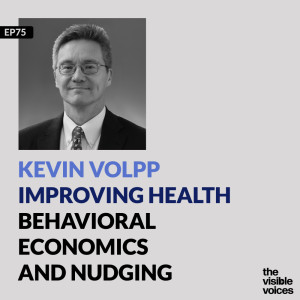
Tuesday Jun 28, 2022
Tuesday Jun 28, 2022
Kevin Volpp MD PhD is the founding Director of the Center for Health Incentives and Behavioral Economics (CHIBE), Division Chief of Health Policy for the Department of Medical Ethics and Policy, and the Founders President’s Distinguished Professor of Medicine at the Perelman School of Medicine and Health Care Management at the Wharton School of the University of Pennsylvania. He has led CHIBE since its inception turning it into an entity that involves more than 90 faculty members and trainees across the University of Pennsylvania and which was 1 of 2 original NIH Centers nationally on behavioral economics and health. Dr. Volpp’s work focuses on developing and testing innovative ways of applying insights from behavioral economics in improving patient health behavior and increasing value in the health system by influencing provider performance. He has competitively been awarded more than $70 million to lead projects with a variety of employers, insurers, health systems, and consumer companies in testing the impact of different behavioral economic strategies on behavior.Dr. Volpp has published more than 250 articles, book chapters, and commentaries, and his work has served as the foundation for numerous widely implemented programs such as benefit design initiatives using financial incentives for smoking cessation among GE and CVS employees, a prescription refill synchronization program for Humana members, a simple health insurance plan called “Humana Simplicity”, and an ‘enhanced active choice’ approach used among tens of millions of CVS members to increase the ease of receiving automated medication refills.Penn Medicine's Nudge Unit is the world's first behavioral design team embedded within a health system. We leverage insights from behavioral science and implementation science to design, implement, evaluate, and disseminate scalable nudges to steer medical decision-making toward higher-value care, improved patient outcomes, and more equitable health care delivery. Follow Kevin on Twitter and follow CHIBE on Twitter.
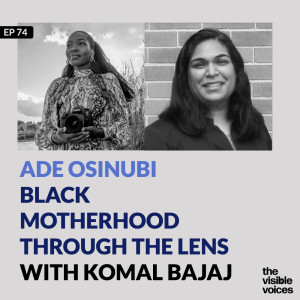
Friday Jun 17, 2022
Friday Jun 17, 2022
Black Motherhood Through the LensDr. Komal Bajaj is an innovator and healthcare leader based in New York City, catalyzing quality and safety transformation across all facets of healthcare delivery. Dr. Bajaj is the Chief Quality Officer of NYC Health + Hospitals/Jacobi/NCB. She is also Clinical Director for NYC Health + Hospitals Simulation Center, which delivers more than 12,000 interprofessional participant encounters throughout its 9 simulation centers annually. She co-chairs the health system’s Monitoring & Evaluation Subcommittee for its Equity & Access Council. Dr. Bajaj is a Professor of Obstetrics & Gynecology at Albert Einstein College of Medicine. She was recently appointed to the AHRQ National Advisory Committee, a 20-member board that advises the Secretary of Health and Human Services and AHRQ Director on priorities for a national health service research agenda. Ade Osinubi is a documentary filmmaker, photographer, and an Emergency Medicine Resident Physician at the University of Pennsylvania. She is a recent graduate from the Warren Alpert Medical School of Brown University. Ade's work focuses on sharing the stories of minority populations that often go untold. At the age of 16, Ade traveled to Mekelle, Ethiopia to co-produce her first documentary. Since then, Ade has produced films educating the public about various health topics ranging from the COVID-19 vaccine to postpartum pelvic floor conditions. Starting from her first year of medical school, she independently filmed and produced Black Motherhood through the Lens, a documentary about four Black women’s experiences in navigating infertility, childbirth, and postpartum mood disorders. Black Motherhood through the Lens has been accepted to 7 film festivals including the American Public Health Association Film Festival and it received the “2021 Best Short Collective Award” at the Rhode Island Black Film festival. Her work on the documentary was also recently recognized in Forbes Magazine amongst other places. In addition to filmmaking, Ade has published articles for the Washington Post and Glamour Magazine on topics related to health equity. She was recently named a National Minority Quality Forum 2022 40 under 40 Leader in Health and is a member of the Alpha Omega Alpha and Gold Humanism Honor Societies. In the future, Ade hopes to pursue a career in health journalism, using her passion for photography and film to elevate the voices of communities of color.

Tuesday Jun 07, 2022
Tuesday Jun 07, 2022
Hella Pick was born in Vienna, came to the UK on a Kindertransport and has lived in UK since 1939. She is a Graduate of the London School of Economics, was awarded a CBE in 2000, and received an honorary doctorate from Sussex University in 2018. She is a British-Austrian journalist who spent 35 years reporting for the Guardian in Washington, at the UN and all over Europe. Her memoir Invisible Walls was published in 2021She was on the staff of the Guardian newspaper from 1961- 1997, working first as UN correspondent, later Washington correspondent, East-West affairs correspondent, Diplomatic Editor, and Associate Foreign Affairs Editor. She has been a frequent contributor to BBC news programs and appearances on German and Austrian TV.Since 1998 she has worked a Senior consultant first for Lord Weidenfeld’s Club of Three and after its foundation for his Institute of Strategic Dialogue, where she became Director of the Arts and Culture Programme organising international meetings on political/strategic, economic and arts issues, and also for five years an annual Europe-China Media exchange project. Hella has served on the Advisory Board of the German-Jewish Studies Centre at Sussex University for more than 10 years, and on behalf of Lord Weidenfeld was closely involved in the establishment of the Chair of Israel Studies at Sussex University. She is currently acting in an advisory capacity for the establishment of the Sussex University Weidenfeld Institute of Jewish Studies She is the author of Simon Wiesenthal - A Life in Search of Justice published by Weidenfeld & Nicolson (1996). Her latest book , her memoir is Invisible Walls – a Journalist in search of her Life’ was published by Weidenfeld&Nicolson (2021).
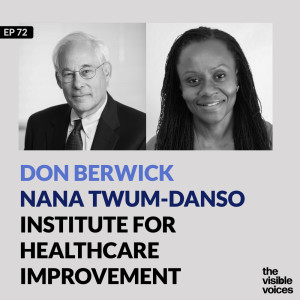
Monday May 09, 2022
Monday May 09, 2022
Donald M. Berwick, MD, MPP, FRCP, President Emeritus and Senior Fellow, Institute for Healthcare Improvement, is also former Administrator of the Centers for Medicare & Medicaid Services. A pediatrician by background, Dr. Berwick has served on the faculty of the Harvard Medical School and Harvard School of Public Health, and on the staffs of Boston's Children's Hospital Medical Center, Massachusetts General Hospital, and the Brigham and Women's Hospital. He has also served as Vice Chair of the US Preventive Services Task Force, the first "Independent Member" of the American Hospital Association Board of Trustees, and Chair of the National Advisory Council of the Agency for Healthcare Research and Quality. He served two terms on the Institute of Medicine's (IOM's) Governing Council, was a member of the IOM's Global Health Board, and served on President Clinton's Advisory Commission on Consumer Protection and Quality in the Healthcare Industry. Recognized as a leading authority on health care quality and improvement, Dr. Berwick has received numerous awards for his contributions. In 2005, he was appointed "Honorary Knight Commander of the British Empire" by Her Majesty, Queen Elizabeth II in recognition of his work with the British National Health Service. Dr. Berwick is the author or co-author of over 160 scientific articles and six books. He currently serves as Lecturer in the Department of Health Care Policy at Harvard Medical School. Follow Don on TwitterNana Twum-Danso, MD, MPH, FACPM, Senior Vice President, Global, Institute for Healthcare Improvement (IHI), leads all global strategy and client development, with top-line revenue responsibility. Previously she was Managing Director for Health at The Rockefeller Foundation, overseeing a strategy designed to transform the practice of public health through data science. She is a public health and preventive medicine physician with 20 years of experience in health policy, practice, strategy, monitoring, learning, evaluation, research, and philanthropy at local, national, and international levels. Dr. Twum-Danso is also an Adjunct Assistant Professor in the Department of Maternal and Child Health at the Gillings School of Global Public Health at the University of North Carolina, Chapel Hill. She worked at the Task Force for Global Health in Atlanta, Georgia; was Director of IHI’s nationwide CQI initiative in Ghana; Senior Program Officer in the MNCH Department at the Bill & Melinda Gates Foundation; independent consultant; and Founder and CEO of MAZA, a social enterprise that provided on-demand health care transportation for pregnant women and sick infants in remote areas of Ghana. She also served on technical advisory committees for the World Health Organization, the US National Academy of Sciences, Engineering and Medicine, and the Canadian International Development Research Centre. Dr. Twum-Danso received her undergraduate and medical education from Harvard University and her public health and preventive medicine residency training from Emory University. Follow Nana on Twitter.
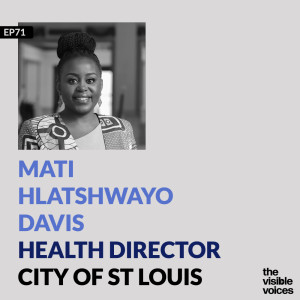
Monday Apr 25, 2022
Monday Apr 25, 2022
Dr. Matifadza (Mati) Hlatshwayo Davis is a Zimbabwean born, American based physician and public health expert in Missouri. Her subspecialty is infectious diseases, with a focus on community engagement addressing health disparities amongst people from historically marginalized groups. She serves as the Director of Health for the City of St. Louis Department of Health.Follow Mati on Twitter and LinkedIn







